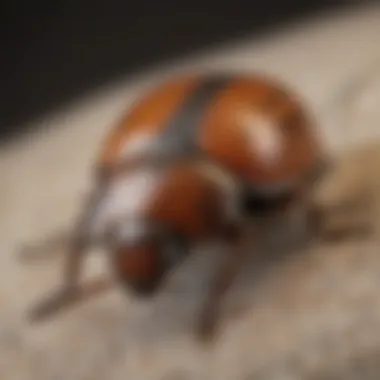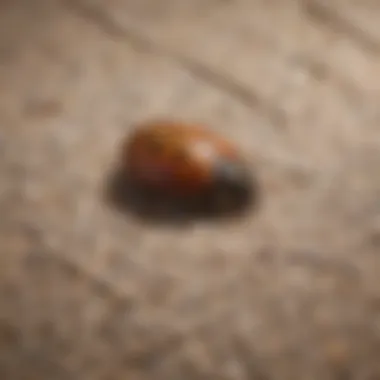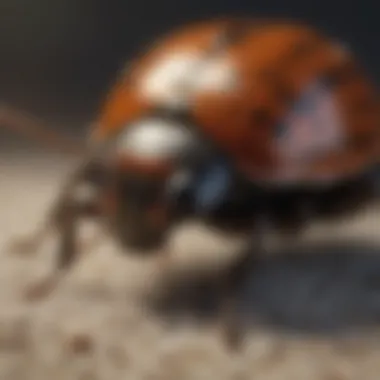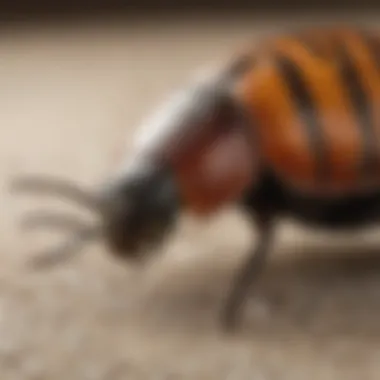Understanding Carpet Beetle Infestations in Homes


Intro
Carpet beetles are small insects that often pose a significant problem in human environments. Their infestations can lead to damage of household items, specifically fabrics and natural fibers. Understanding these pests is crucial for effective management and prevention. This article will cover key points, detailing their biology, behaviors, and how they affect human households and ecosystems.
Animal Overview
Common Names
Carpet beetles are commonly known as household pests. They may also be referred to as black carpet beetles, varied carpet beetles, or furniture carpet beetles based on their specific type.
Scientific Classification
The carpet beetle belongs to the family Dermestidae. Scientifically, these beetles are categorized into different genera, the most notable being Anthrenus.
Geographic Range
Carpet beetles are widely distributed around the globe. They can commonly be found in temperate regions, particularly in North America and Europe, establishing their presence in human dwellings.
Behavior and Social Structure
Social Behavior
Carpet beetles do not exhibit social behavior like some insects. They are solitary and primarily concerned with finding food and mating.
Communication
Communication among carpet beetles is minimal. They rely on pheromones for reproduction and territorial cues.
Mating and Reproduction
The mating process involves the male attracting the female through chemical signals. After mating, females lay eggs in environments where larvae can find food. These larvae are the most damaging to textiles, as they feed on organic materials.
Habitat and Ecosystem
Natural Habitat
Carpet beetles thrive in environments rich in their food sources. They are often found in homes where they can access textiles and stored products.
Food Sources and Diet
These beetles are scavengers. They primarily feed on natural fibers found in carpets, clothing, and other household items made from wool, silk, or cotton.
Role in Ecosystem
Carpet beetles play a role in the decomposition of organic materials. They recycle nutrients back into the environment, contributing to a healthy ecosystem despite their nuisance in human settings.
Important Note: Despite their ecological role, the presence of carpet beetles in a home should be managed swiftly to avoid damage to personal belongings.
Understanding the nature of carpet beetles allows homeowners to take appropriate measures against infestations. Knowledge of their behavior and ecosystem role can aid in developing effective prevention and management strategies.
Prelude to Carpet Beetles
Carpet beetles are small pests that can significantly impact human dwellings. They pose challenges not only as nuisances but also as potential causes of damage to various materials in the home. Understanding carpet beetles is crucial for effective management and prevention strategies. This knowledge can help homeowners minimize the risk of infestation, saving both time and money.
Overview of Carpet Beetle Species


There are several species of carpet beetles, with the most common being the varied carpet beetle, the black carpet beetle, and the common carpet beetle. The varied carpet beetle, known as Anthrenus verbasci, has a mottled appearance with various color patterns, while the black carpet beetle, Attagenus unicolor, is entirely black and often larger in size. The common carpet beetle, Anthrenus scrophulariae, can also be found in many homes. Each species has unique habits and preferences when it comes to nesting and feeding.
These beetles are generally attracted to areas with access to organic materials, such as wool, silk, and other animal products. Understanding the specific species present in a home can aid in identifying their nesting sites and in implementing targeted control measures.
Life Cycle of Carpet Beetles
The life cycle of carpet beetles consists of four main stages: egg, larva, pupa, and adult. The eggs are tiny, often laid in hidden spaces like under furniture or inside closets. A female carpet beetle can lay up to 100 eggs at a time, leading to rapid population growth.
After 7 to 10 days, the eggs hatch into larvae, which are the most destructive stage of the beetle's life cycle. Larvae feed on various organic materials, causing significant damage to carpets, clothing, and upholstery. They can remain in this larval stage for several months, depending on environmental conditions and food availability.
When conditions are favorable, the larvae will enter the pupal stage, transforming into adult beetles. Adults live for a few weeks to several months, depending on the species, and typically seek out mates to continue the reproductive cycle. Understanding this life cycle is vital for effective pest control, as targeting the larvae stage is the most effective way to reduce populations.
Key Points: Being aware of the life cycle stages of carpet beetles is essential for targeted interventions and effective management. Regular inspections can help identify infestations early and inhibit further damage.
Signs of Carpet Beetle Infestation
Carpet beetles are more than just a nuisance. Recognizing the signs of infestation early is crucial to preventing more extensive damage in your home. Understanding these signs helps in identifying an actual problem rather than relying on misconceptions. Being informed can save time, reduce costs on treatment, and protect personal belongings from irreparable harm.
Identifying Infestation in Homes
Finding carpet beetles in your home can be alarming. They often go unnoticed until they cause noticeable harm. To identify an infestation, look for several key indicators. Dead beetles or larvae often show up in areas where they thrive. Noticing small, round holes in fabrics can hint at their presence as these insects feed on natural fibers.
Other signs include the appearance of shed skins, which indicate growth as these insects molt. Additionally, spotting tiny eggs in hidden spaces might confirm that an infestation is developing. These creatures are also drawn to light, so you might find them near windows or light fixtures.
Taking immediate action when spotting these signs can help prevent further damage. Regular checks of vulnerable areas are part of maintaining a pest-free environment.
Damage Caused by Carpet Beetles
Understanding the type of damage caused by carpet beetles is essential. Different materials will sustain varying levels of damage.
Textiles and Fabrics
Textiles and fabrics are primary targets for carpet beetles. These pests prefer natural fibers, such as wool, silk, and cotton, as their food source. They can cause significant damages, leaving holes that render items unusable. Techniques in textile manufacturing often include high-quality natural materials, making them popular choices.
However, once these materials become infested, they offer little protection from pest damage. Regular inspections and proper storage is critical to avoiding damage to textiles. One should also consider using fabric protectants and maintaining cleanliness to limit the attraction of carpet beetles to textiles.
Furniture
Furniture crafted from natural materials can also face threats from carpet beetles. Upholstered furniture, particularly those with wool or silk components, can show signs of destruction. It's vital to understand how these insects achieve such damage. They can burrow into seams or under cushions, where they can go unnoticed.
The unique feature of furniture is its durability; however, infested furniture can become unsightly and unsafe over time. Remediation methods should involve both treating the furniture and evaluating surrounding areas so that re-infestation does not occur.
Stored Items
Stored items, such as seasonal clothing or linens, can become prime targets for carpet beetles. The key characteristic about stored items is they are often kept in dark, undisturbed spaces, making them ideal for beetle breeding. These pests are particularly attracted to items that may have food residues, making an occasional cleanup important.
It's crucial to carefully inspect stored items before placing them away for long periods. Considering temperature and humidity in storage areas can help deter infestations. Implementing vacuuming and protecting items with sealed containers can secure stored goods further.
The earlier infestations are identified, the easier and less costly it is to manage and eradicate carpet beetles.
Preventing Carpet Beetle Infestations
Understanding how to prevent carpet beetle infestations is crucial for maintaining a healthy and clean home. Carpet beetles can cause significant damage to fabrics, furniture, and stored items if left unchecked. Preventive measures can save you time, money, and effort in dealing with these pests later on. This section focuses on practical strategies that can be employed to minimize the risk of infestation.
Home Maintenance Strategies
To keep carpet beetles at bay, proper home maintenance is key. Regularly examining your home for potential entry points is a good first step. Check windows, doors, and any cracks in the walls. Sealing these areas can prevent beetles from gaining easy access. Another important aspect of home maintenance is ensuring that outdoor plants and vegetation are kept well-trimmed. This not only enhances your garden but also reduces hiding spots for pests.


Key Home Maintenance Tips:
- Inspect the exterior of your home for gaps and crevices.
- Ensure windows and doors have tight-fitting screens.
- Trim outdoor plants and shrubs regularly.
Proper Storage Techniques
Many infestations often begin in neglected stored items. To prevent carpet beetles from thriving in your belongings, proper storage techniques are essential. Keep items in airtight containers. This is particularly effective for clothing, linens, and other textiles. Additionally, use moisture absorbers in storage areas to keep humidity low, as carpet beetles prefer warmer and more humid environments.
Effective Storage Practices:
- Use sealed plastic bins for storing fabrics and other items.
- Keep seasonal clothing clean before packing.
- Store food items in airtight containers, if applicable.
Regular Cleaning Practices
Regular cleaning is a powerful tool against carpet beetles. A meticulous cleaning routine significantly reduces the potential for an infestation. It's advisable to vacuum areas where carpet beetles are likely to hide, like under furniture or in carpets. Pay attention to areas like baseboards and corners, where dust and debris can accumulate.
Cleaning Checklist:
- Vacuum carpets and rugs frequently, focusing on corners and edges.
- Wash linens and clothing regularly, especially items that are stored.
- Dust surfaces to remove any eggs or larvae that may be present.
Adopting these preventive measures can greatly reduce the likelihood of a carpet beetle infestation. By placing a systematic approach to home maintenance, proper storage, and regular cleaning into practice, you safeguard your home from the threats posed by these pests.
Methods of Control and Treatment
Controlling and treating carpet beetle infestations is critical for protecting your home and belongings. The topic of methods to manage this pest addresses several important elements. Effective control strategies can prevent the extensive damage caused by carpet beetles, which can devour textiles and stored items. Furthermore, understanding various treatment methods allows individuals to make informed choices tailored to their specific situations and preferences.
Chemical Treatments
Chemical treatments are among the most common methods used to manage carpet beetle infestations. These treatments usually involve insecticides that target the adult beetles along with their larvae. When choosing a product, it is essential to select one specifically formulated for carpet beetle control. Brands such as Ortho and Raid offer appropriate solutions. It is vital to follow the manufacturer's instructions for application to ensure safety and effectiveness.
Considerations for Chemical Treatments:
- Always read and understand safety labels before use.
- Apply products in well-ventilated areas to minimize inhalation risks.
- Wear protective clothing and equipment when applying chemicals.
- Store chemical products out of reach of children and pets.
Natural Control Methods
For those who prefer an eco-friendlier approach, natural control methods offer effective alternatives to chemical treatments. These methods can be safer for humans and animals while still managing the carpet beetle population effectively. Some popular natural remedies include:
- Diatomaceous Earth: This powdery substance is abrasive to insects. When carpet beetles come in contact with it, their exoskeletons become damaged, leading to dehydration. Sprinkle it in affected areas for effective control.
- Essential Oils: Oils such as lavender, peppermint, and eucalyptus act as natural repellents. Dilute the oils in water and spray them in areas where carpet beetles are likely to reside.
- Vinegar Solutions: A vinegar-water mixture can also deter beetles. Spray it on fabrics and other surfaces to reduce the potential infestation.
Selecting natural methods can reduce chemical exposure while still protecting your living environment.
Professional Pest Control Services
When an infestation becomes severe, professional pest control services can provide the expertise and resources needed for effective management. These services often utilize a combination of chemical and non-chemical approaches for comprehensive solutions. Professionals assess the severity of the invasion and then recommend tailored treatments based on their findings.
Benefits of Professional Services Include:
- Expertise: Pest control technicians are trained to identify beetle species and the extent of the infestation.
- Effective Solutions: Professionals have access to more potent treatment options that may not be available to average consumers.
- Follow-Up Services: After the initial treatment, professionals may offer ongoing monitoring to prevent re-infestation.
Engaging a professional service means an investment in the long-term protection of your home and belongings.
Choosing the right method of control is crucial. Weigh your options carefully to tailor a solution that meets your needs while ensuring safety and effectiveness.
Carpet Beetles and Human Health


Carpet beetles may seem like a minor nuisance, but their presence in human environments can lead to significant health concerns. Understanding the health implications associated with carpet beetles is crucial for effective management and prevention strategies. While carpet beetles do not pose direct threats like some pests, they can indirectly impact human health through allergic reactions and misleading myths.
Allergic Reactions to Carpet Beetles
People can develop allergic reactions to carpet beetles or their larvae. These reactions may occur due to contact with the insects or exposure to shed skins and frass. Common symptoms can include skin rashes, itchy eyes, and respiratory issues. Such responses can be particularly concerning for individuals with existing allergies or respiratory conditions, amplifying their discomfort.
- Severity of Reactions: While some may only experience mild symptoms, others could face severe reactions needing medical attention.
- Prevalence: Allergies to carpet beetles are more frequent than many realize, yet they often go unnoticed or misdiagnosed.
“Awareness of carpet beetle allergies can lead to more timely and effective responses.”
The importance of understanding the relationship between these beetles and human health cannot be understated. Regular cleaning and monitoring of living spaces can minimize exposure to the allergens they produce.
Myths Surrounding Carpet Beetles
Many myths exist about carpet beetles that can mislead individuals about their threats and behaviors. Dispel these myths to promote better understanding and proactive measures against infestations.
- Myth 1: Carpet beetles only infest dirty homes: This is incorrect. These pests are attracted to organic materials like wool, fur, and pet hair, irrespective of a home's cleanliness.
- Myth 2: Carpet beetles bite humans: Unlike bed bugs or fleas, carpet beetles do not bite. Most health concerns arise from allergens rather than direct attacks.
- Myth 3: All electronic pest control methods are effective: Relying solely on electronic traps can provide a false sense of security, as they may not eliminate all signs of infestation.
Understanding these myths helps in managing not only the presence of carpet beetles in a given environment but also the perceptions that can often create unnecessary fear and confusion. The more informed individuals are about carpet beetles, the more effectively they can address potential infestations and associated health concerns.
The Role of Education in Prevention
Education plays a critical role in preventing carpet beetle infestations. Understanding the behaviors and habits of these pests empowers individuals to take proactive measures. With knowledge, one can recognize the warning signs early, facilitating quicker responses that can avert larger infestations.
Awareness about carpet beetles should not only be limited to pest control professionals. Homeowners, educators, and students can benefit immensely from understanding how these pests operate. By learning about their lifecycle, behaviors, and preferences, individuals can create an environment that is less conducive to infestation.
Benefits of Education
- Early Detection: Knowledge of carpet beetle signs enables quicker identification of an infestation.
- Informed Preventive Measures: Education encourages individuals to implement effective methods for prevention.
- Reduced Pest Control Costs: Understanding and monitoring can lessen the need for expensive extermination services.
- Community Awareness: Educated individuals can spread information within their communities, enhancing overall awareness.
Education is the foundation of proactive infestation management. The more people know, the less likely infestations occur.
Increasing Awareness of Carpet Beetles
Increasing awareness regarding carpet beetles and their potential impact on human living spaces is essential. Educational initiatives can utilize various platforms and methods like workshops, seminars, and even social media campaigns. Schools and community organizations could introduce programs aiming to educate students and residents about pest behavior, signaling a commitment to maintaining pest-free living areas. It’s not only about avoiding infestations; it's about fostering an understanding of the ecosystem and respecting all life forms, including pests, through appreciation and knowledge.
Resources for Further Learning
For those interested in broadening their understanding of carpet beetles, many resources are available. Some suggested options include:
- Books: Guides to pest management and identification are useful. Look for titles specifically focused on entomology and household pests.
- Online Courses: Websites like Coursera and edX may offer courses on pest management.
- Local Extension Services: Many universities provide information on local pest control strategies, often published in accessible formats.
- Websites: Visit sites like Wikipedia for general information or Britannica for deeper articles.
Engaging with these resources can significantly enhance one's ability to control and prevent carpet beetle infestations effectively.
Ending
Understanding carpet beetle infestations is crucial for maintaining healthy living environments. This article highlighted the biology, identification, and treatments related to these pests. Recognizing signs of infestation and damage is essential for prompt intervention.
Effective prevention strategies, including home maintenance and proper storage, can significantly reduce risks. Knowledge plays a key role in managing carpet beetles. Educational resources available can empower individuals to take action against infestations.
"Awareness is the first step towards prevention."
Summary of Key Points
- Carpet beetles can cause significant damage to textiles, furniture, and stored items.
- Early detection of signs helps in controlling infestations quickly.
- Regular cleaning and proper storage are critical preventive measures.
- Treatment options range from chemical solutions to natural methods and professional services.
- Allergic reactions to carpet beetles are real and should not be overlooked.
- Misinformation can spread about these pests; awareness can address many myths.
Final Thoughts on Management Strategies
Managing carpet beetles involves a multifaceted approach. Incorporating a thorough understanding of their habits and lifecycle is beneficial. Consider both preventive measures and treatment options.
Maintaining cleanliness, especially in areas where fabric is stored, is vital. Proper disposal of potential food sources for beetles acts as a deterrent. In severe cases, consulting pest professionals might be necessary.
Continued education and awareness are the foundation for effective management. By prioritizing this issue, individuals can protect their homes from the unwanted presence of carpet beetles.







